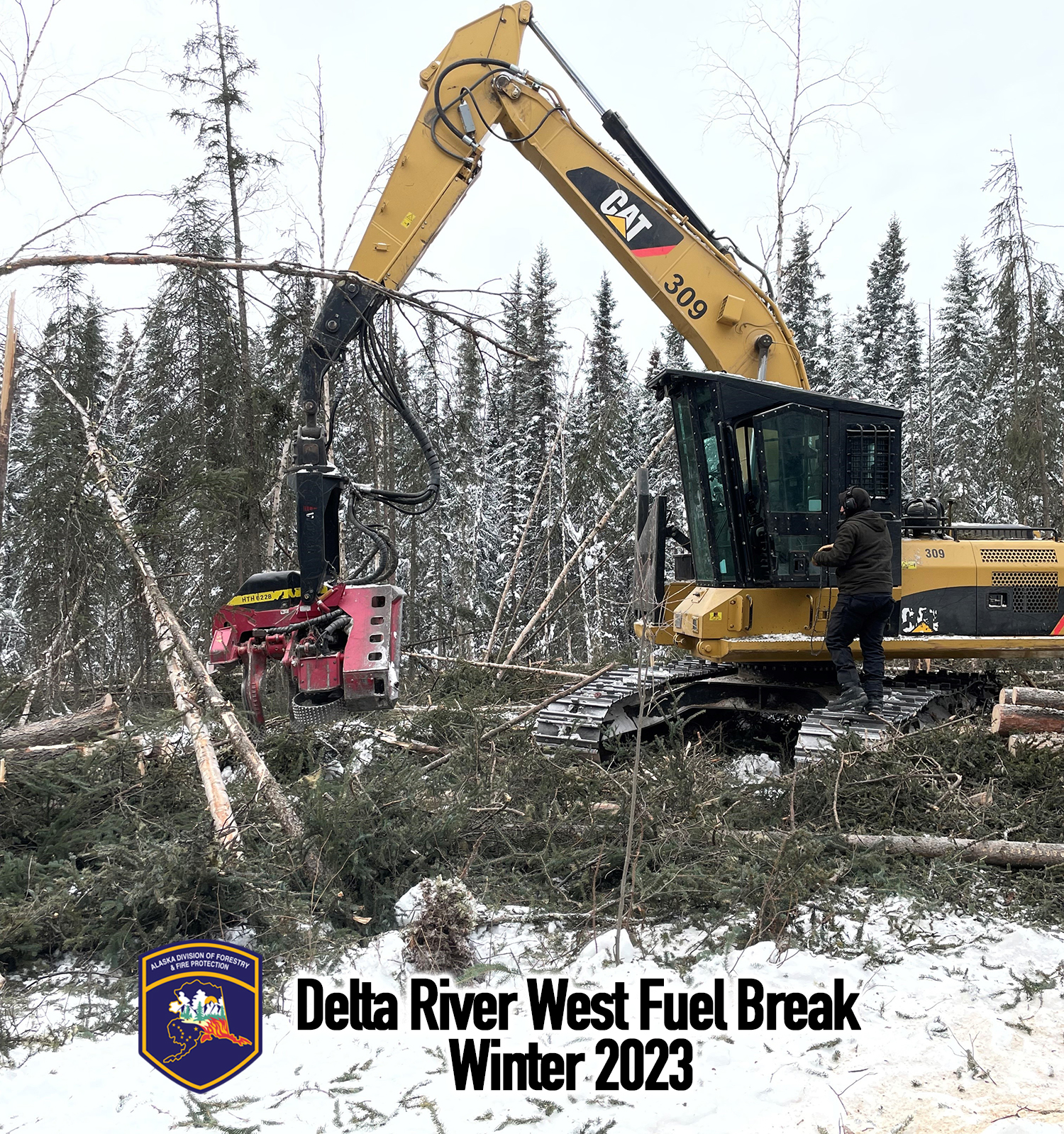Fuel breaks serve the important purpose of protecting homes while mitigating the risk of putting firefighters on the ground.
A critical new fuel break was completed over the winter months by a Division of Forestry & Fire Protection contractor west of Delta Junction. Celebrated by fire personnel for providing safe defensible space, the work was accomplished using two methods. Larger diameter trees have been felled and decked for later firewood sales. Smaller trees were fully mitigated using a mix of treatments including shearblade, roller chopper and masticating head hydro-ax. This section of protection line runs north/south along an access road and parallels the Delta River.
Residents of Delta Junction, Fort Greely and homeowners in the surrounding areas have a deep understanding of the frequent fire return interval in this part of interior Alaska. Large wildfires totaling nearly 200,000 acres threatened this area in 1998, 2013, 2014 and most recently with the 2019 Oregon Lakes Fire. A coordinated interagency effort has been underway for years between DOF, the Bureau of Land Management Alaska Fire Service (BLM AFS), and the 11th Airborne Division. Fire managers from several agencies have been working to mechanically remove hazard fuels in the fuel break constructed in the Donnelly Training Area West (DTAW), along Fort Greely and west of Delta Junction.
The Delta River West fuel break will continue east/west towards the Little Delta River. Federal Good Neighbor Authority will provide funding for an additional 1,095 acres left to treat. This section will similarly give fire personnel protecting the Whitestone Community a larger defensible space to protect homes, infrastructure and riparian corridors.
A long held DOF and interagency goal has been to mitigate the risk of putting firefighters on the ground in these areas with numerous values at risk. This line is specifically in place out of the nearby areas that are known to agency administrators from BLM Alaska Fire Service Military Fire Management Zone and the 11th Airborne Division as likely to have unexploded ordnance (UXOs) and other military debris. Not all the ordnance used over decades of military training at Fort Greely detonates, leaving unstable and unsafe areas where fire crews cannot be placed due to safety concerns. Fire managers could consider the river itself, which is much wider, to be a more natural fire break that would be more likely to hold. However, fire managers have determined it would be difficult and with higher risk to put firefighters in along the river to hold a line. These 349 acres provide fire crews with excellent access along the Limited and Full Suppression Areas boundary that is just to the west of Delta Junction.
Is it Better to Make Fuel Breaks in the Winter Months?
Removing fuels with machines, typically referred to as mechanical or mechanized treatment, is often performed in the winter months by contractors. The snow cover and frozen ground is more supportive of the typical heavy mastication equipment contractors use. When conditions are ideal, vegetation is protected and the compaction of the soil and the residual trees root systems is minimized. To ensure that the project remained in compliance with appropriate permits, the snow and frost depths in the target work areas were monitored by project managers and the private contractor. With the urgency to complete fuel breaks before this summer’s wildfire season, the contractor took advantage of ongoing favorable conditions.
When there are sensitive areas, DOF’s firefighting staff used chain saws to create shaded fuel breaks, which maintain forest canopy cover while removing the hazardous fuels. This “soft touch” work can be performed as a preparation for the wildfire season in spring, or throughout the summer and fall. With the passage of House Bill 209, DOF is able to hire Emergency Firefighters (EFFs) to work on fuels projects during off season and over the winter months.
Why So Many Fires near Delta Junction, Whitestone & Fort Greely?
This area has been subject to a frequent fire return interval that is not normally seen in interior Alaska. The fuels west and south of Delta Junction, Whitestone & Fort Greely have changed in many cases from forested to grass. The area is known for the vast and beautiful views of the Alaska Range, along with the steady winds that blow across the Donnelly Training Area whipping dust up from the Delta and Tanana River corridors. These same winds are known for rapidly pushing fires from wide open military lands north towards structures. This could potentially lead to more frequent fires, particularly in the early season before green-up when dead and dry vegetation becomes exposed.

About the Hazard Fuel Reduction Program
The State of Alaska, Division of Forestry & Fire Protection, manages an active Hazard Fuel Reduction Program. The objective is straight forward; remove enough vegetation (fuel) so that when a wildfire burns, it is less severe and can be more easily managed.
Read about the Sunset Fuel Break protecting Houston, Meadow Lakes and Wasilla.
Stop by for a visit to pick up your 2023 burn permits (required April 1st – August 31st) or learn about upcoming trainings!
![]() Online burn permits can be downloaded at https://dnr.alaska.gov/burn
Online burn permits can be downloaded at https://dnr.alaska.gov/burn
![]() Red Card classes and trainings can be viewed at https://forestry.alaska.gov/training/
Red Card classes and trainings can be viewed at https://forestry.alaska.gov/training/
Categories: AK Fire Info, Alaska DNR - Division of Forestry (DOF), BLM Alaska Fire Service, Fire Prevention, Firewise, Fuel Break Project




